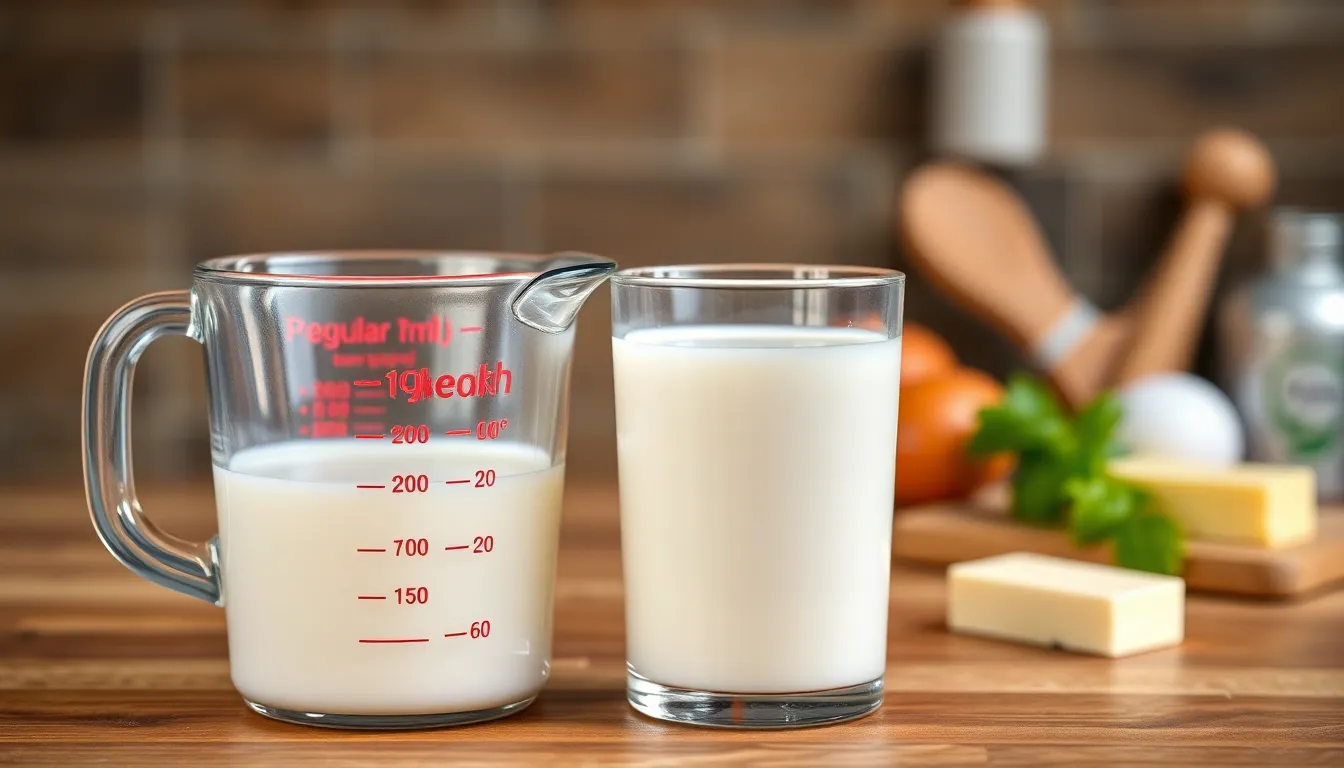Table of Contents
ToggleIn the world of cooking and baking, ingredient substitutions can make all the difference. When a recipe calls for milk and the pantry is bare, many wonder if evaporated milk can step in as a suitable replacement. This versatile ingredient, often found in creamy soups and desserts, offers a unique flavor and texture that might surprise even seasoned cooks.
Evaporated milk is concentrated milk with about 60% of its water removed, resulting in a rich and creamy consistency. It’s not just a pantry staple; it’s also a great alternative for those looking to enhance their dishes without sacrificing taste. Understanding how to effectively substitute evaporated milk for regular milk can elevate recipes and provide a delicious twist in the kitchen.
Overview of Evaporated Milk
Evaporated milk is a shelf-stable dairy product created by removing approximately 60% of its water content. This process results in a thicker, creamier texture compared to regular milk. Evaporated milk retains essential nutrients such as calcium, vitamin D, and potassium, making it a nutritious choice for various recipes.
Evaporated milk functions well in both sweet and savory dishes. Its rich consistency enhances sauces, soups, and custards, adding a velvety mouthfeel without overwhelming flavors. In baking, evaporated milk can substitute regular milk while contributing to moistness in cakes and breads.
Cooks often find evaporated milk convenient due to its long shelf life and versatility. It can serve as a base for creamy soups, be mixed into oatmeal, or enhance cereal. When it comes to substitutions, using equal amounts of evaporated milk in place of milk effectively achieves the desired richness in recipes.
Nutritional Comparison

Evaporated milk offers a unique nutritional profile compared to regular milk. Understanding the differences in calories, fat content, vitamins, and minerals enhances the decision-making process when using it as a substitute.
Calories and Fat Content
Evaporated milk contains about 60 calories per 1-ounce serving, while whole milk has approximately 18 calories in the same amount. Fat content varies, with evaporated milk typically containing around 6 grams of fat per 100 grams, while whole milk has about 3.25 grams. Reduced-fat or skim options reduce calories and fat content, making switches possible based on dietary needs.
Vitamins and Minerals
Evaporated milk retains vital nutrients similar to those found in regular milk. It contains approximately 30% more calcium than whole milk, providing about 300 milligrams per cup. Additionally, it has significant amounts of vitamin D and potassium. Regular milk also offers these nutrients, with vitamin D contributing to calcium absorption and potassium aiding in blood pressure regulation. Each option provides essential vitamins and minerals, supporting overall health and nutrition goals.
Cooking and Baking Uses
Evaporated milk serves as a valuable substitute for regular milk in various cooking and baking applications. Its rich texture and concentrated flavor make it an excellent choice for enhancing numerous recipes.
When to Use Evaporated Milk
Evaporated milk works best when recipes benefit from creaminess and depth. It’s suitable for dishes like creamy soups, sauces, and casseroles where added richness enhances flavor. When making custards or puddings, its thick consistency improves overall texture. Baking recipes can also benefit from the substitution, especially those requiring moisture, such as cakes, muffins, and quick breads. Evaporated milk can replace regular milk in equal amounts, ensuring a seamless transition without significant alterations to the initial recipe.
Recipes That Can Benefit from Substitution
Several recipes showcase the strengths of evaporated milk as a substitute:
- Creamy Soups: Use in potato or tomato soups to achieve a velvety finish.
- Sauces: Incorporate into cheese or Alfredo sauces for a richer taste.
- Baking: Utilize in cakes, brownies, pancakes, and muffins to add moisture and flavor.
- Puddings and Custards: Enhance texture by substituting for regular milk, resulting in a creamier dish.
- Oatmeal: Switch out regular milk for evaporated milk to create a more luxurious breakfast option.
- Coffee and Hot Chocolate: Substitute for an indulgent, creamy drink.
By applying evaporated milk in these dishes, cooks can elevate flavor and maintain desired consistency.
Pros and Cons of Substitution
Using evaporated milk as a substitute for regular milk presents various advantages and disadvantages that cooks should consider. Understanding these factors aids in making informed decisions during the cooking or baking process.
Advantages of Using Evaporated Milk
- Rich Creaminess: Evaporated milk offers a thicker and creamier texture compared to regular milk. It adds depth and richness to dishes like sauces, soups, and desserts.
- Enhanced Flavor: Evaporated milk intensifies flavors in recipes. This property enhances both savory and sweet dishes, enriching them without overpowering the original taste.
- Nutritional Benefits: Evaporated milk contains higher concentrations of essential nutrients, including calcium and vitamin D. These nutrients support overall health, contributing positively to dietary needs.
- Long Shelf Life: The preservation process gives evaporated milk an extended shelf life. This feature allows for convenient stocking without frequent shopping trips, making it a practical choice in many kitchens.
- Versatility: Evaporated milk can be used in various recipes, from baking to cooking. It performs well in creamy soups, baked goods, and even beverages, making it a flexible ingredient for diverse culinary applications.
Disadvantages to Consider
- Higher Caloric Density: Evaporated milk contains more calories and fat than regular milk. This factor may not align with all dietary goals, particularly for those monitoring caloric intake.
- Altered Taste Profile: Some recipes may experience a slight change in flavor when using evaporated milk. The concentrated nature might influence specific subtle tastes, which may not suit every dish.
- Requires Dilution for Drinking: Evaporated milk is not typically consumed straight. It often requires dilution with water to resemble the consistency and taste of regular milk, complicating its use in specific applications.
- Limited Availability: In some regions, evaporated milk may not be readily available. This limitation can hinder its use in recipes that rely on this specific ingredient.
- Potential for Clumping: When heated rapidly, evaporated milk can curdle or clump. This potential requires careful attention during cooking processes where high temperatures are involved.
Evaporated milk is a valuable alternative to regular milk in a variety of recipes. Its rich and creamy texture can elevate both sweet and savory dishes, providing a depth of flavor that enhances the overall experience. With its nutritional benefits and long shelf life, it’s a convenient choice for many cooks.
While there are some considerations to keep in mind, such as its higher caloric density and potential taste differences, the advantages often outweigh the drawbacks. By understanding how to properly use evaporated milk, cooks can confidently incorporate this ingredient into their culinary repertoire, transforming everyday meals into delightful creations.







